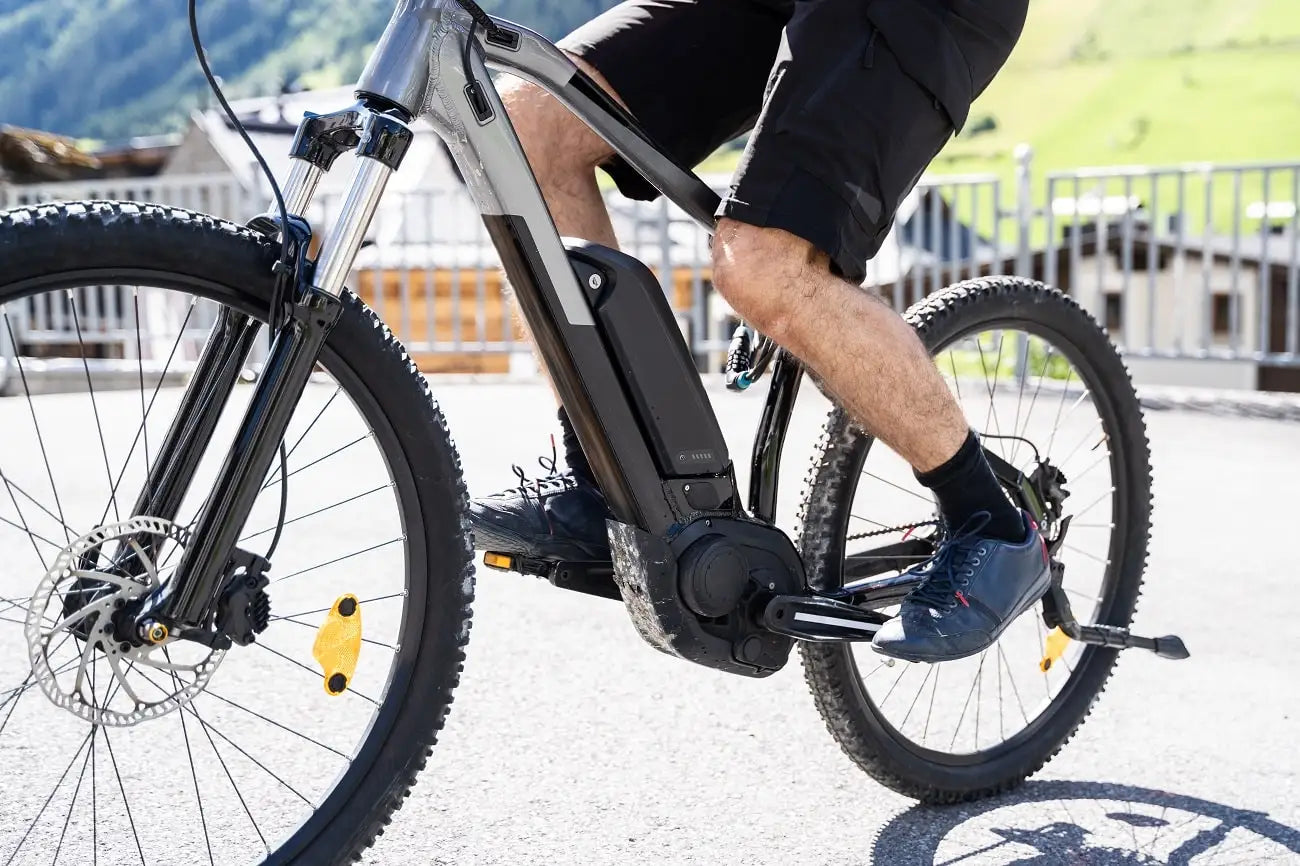
How to Choose an Ebike: a Full Buying Guide
Updated: 11/13/23
If you're in the market for an ebike and you feel like your head is spinning, we at RydyBikes get it. There are so many options out there it can feel overwhelming! But don't worry, our team has tested our fair share of electric bikes, and we're here to walk you through everything you need to know to find your perfect match.
With the rising popularity and diverse range of electric bicycles now available, it's important to understand the different classes, features, regulations, and components in order to find the ideal ebike for your specific purposes. Luckily, our team at RydyBikes has done the research for you. We'll go over all the nitty gritty details like motor power, battery life, range, accessories, and more. We'll even decode those complicated regulations and technical specs into plain English so you can feel informed, not overwhelmed.
What Is an Ebike?
An ebike, also known as an electric bicycle, is a standard bicycle equipped with an integrated electric motor and battery system to assist with pedaling. The electric motor augments the rider's pedal power, making it easier to ride for longer distances, ascend hills, carry cargo, and tackle various terrains. Electric bicycles use sensors that detect when the rider is pedaling and activates the motor to provide extra propulsion. The electric pedal assist cuts off once the electric bike reaches 15-28 mph, depending on the class.
So, electric bikes open up your cycling possibilities while still being lightweight and efficient. With electric bikes you can ride at your own pace - cruise leisurely or get your heart pumping. On top of that, they're a greener transportation option than most vehicles.
Understanding the Electric Bike Classes
When shopping for an e-bike, one of the most important factors to understand is the class system. The class determines key aspects like how fast the e-bike can go and what kind of electric motor assistance is allowed. There are three main classes:
Class 1 - Electric Bikes
Class 1 e-bikes are the most common and the most affordable option, with prices starting at around $1,000. They have a pedal assist system that provides power up to 20 mph but does not have a throttle. This means that you must pedal to move the bike, but the motor will help you to go faster and easier. Class 1 e-bikes are allowed on most bike paths and roads, great for those looking for commuter bikes.
Class 2 - Electric Bikes
Class 2 e-bikes are similar to Class 1 e-bikes, but they also have a throttle that can be used to power the bike without pedaling. They are typically more expensive than Class 1 e-bikes, with prices starting at around $1,500. The throttle can be used to reach speeds up to 20 mph. Class 2 e-bikes are allowed on most bike lanes and roads, but some jurisdictions may have restrictions.Class 3 - Electric Bikes
Class 3 e-bikes are the fastest type of e-bike, and are the most expensive option, with prices starting at around $2,000. They have a pedal assist system that provides power up to 28 mph and may also have a throttle. Class 3 e-bikes are not allowed on most bike paths and may have other restrictions in certain jurisdictions.
Types of E-bikes

City/Commuter Electric Bicycle
City/commuter e-bikes are designed for everyday riding, such as commuting to work or running errands. They typically have a comfortable upright riding position and a range of features that make them easy to ride in urban environments, such as fenders, lights, and racks.
Perfect for: Commuting, running errands, and getting around town.
Cargo Electric Bicycle
Cargo e-bikes are designed for carrying heavy loads, such as groceries, children, or work equipment. They have powerful motors and large frames that can accommodate a variety of cargo accessories. An electric cargo bike is a good choice for riders who need a way to transport heavy loads without using a car.
Perfect for: Carrying heavy loads, and transporting groceries or children (with the proper accessories).
Folding Electric Bike
Folding bikes are designed to be folded up and transported easily. They are a good choice for riders who need a way to store their e-bike in a small space, such as an apartment or office. Folding e-bikes are also a good choice for commuters who want to be able to take their e-bike on the train or bus.
Perfect for: Commuting, storing in a small space, and transporting on public transportation.
Fat Tire Electric Bike
Fat tire e-bikes are designed for riding on soft surfaces, such as sand, snow, and mud. They have wide, knobby tires that provide excellent traction and stability. Like cargo bikes, fat tire e-bikes are also a good choice for riders who need to carry a lot of gear, as they can be equipped with large racks and.
Perfect for: Riding on soft surfaces, and carrying heavy loads.
Mountain Electric Bicycle
Electric mountain bikes are designed for riding on rough terrain, such as trails, hills, and rocks. They have powerful motors and suspension systems that make them easy to ride over uneven surfaces. An electric mountain bike is a good choice for riders who want to explore new trails or who need a boost to get up steep hills.
Perfect for: Off-road riding, and mountain biking.
Road/Gravel Electric Bike
Road/gravel e-bikes are designed for riding on paved roads and gravel paths. They are lightweight and have aerodynamic frames that make them fast and efficient. Road/gravel e-bikes are a good choice for riders who want to ride long distances or who want to compete in races.
Perfect for: Road riding, gravel riding, racing.
Cruiser Electric Bicycle
Cruiser e-bikes are designed for comfortable and relaxed riding. They have a laid-back riding position and wide tires that provide a smooth ride. Cruiser e-bikes are a good choice for riders who want to enjoy a leisurely ride around town or on the beach.
Perfect for: Leisurely riding, cruising around town.
Factors to Consider When Choosing an E-bike

When choosing an e-bike, there are many factors to consider, including the motor type and rating, battery capacity and voltage, range and charging considerations, battery lifespan and maintenance tips, quality of components, warranty and customer support, weight and portability, price range and budget, and comfort features.
Motor Types, Ratings, and Sensors
There are two main types of e-bike motors: hub motors and mid-drive motors. Hub motors are located in the front or rear wheel, while mid-drive motors are located in the center of the bike.
Hub motors are less expensive than mid-drive motors, but they are also less efficient and can provide less torque. Mid-drive motors are more expensive than hub motors, but they are more efficient and can provide more torque.
E-bike motors are rated in watts, which is a measure of their power. Higher-wattage motors can provide more power and speed, but they also consume more battery power.
E-bike motors also have sensors that detect pedal cadence and torque. These sensors help to modulate the motor's power output, which can improve efficiency and range.
Battery
The battery is one of the most important components of an e-bike. E-bike batteries are typically made of lithium-ion or lead acid. Lithium-ion batteries are more expensive than lead-acid batteries, but they are also lighter and have a higher energy density. By now, most bike shops and bike manufacturers exclusively recommend lithium-ion.
E-bike batteries are rated in amp-hours (Ah), which is a measure of their capacity. Higher-capacity batteries can provide more power and range, but they are also heavier.
E-bike batteries also have a voltage rating, which is a measure of their power output. Higher voltage batteries can provide more power and speed, but they can also be more expensive. Note that E-bike batteries have a limited lifespan, typically around 500 to 1000 charge cycles. To extend the lifespan of an e-bike battery, it's essential to avoid fully discharging the battery and to avoid charging the battery in extreme temperatures.
Weight and Portability
The weight of an e-bike is an important consideration, especially if you plan on carrying it up and down stairs or transporting it in a vehicle.
As mentioned, folding e-bikes are a good option for riders who need a portable e-bike. Folding e-bikes can be folded up and transported easily, making them ideal for commuting and travel.
Quality of Components
The quality of the components on an e-bike impacts performance, durability, and safety.
The frame of an e-bike is typically made of aluminum or steel. Aluminum frames are lighter than steel frames, but they can also be more expensive. Steel frames are more durable than aluminum frames, but they can also be heavier.
The brakes, gears, and suspension systems on an e-bike are also important for performance and safety. Choose reliable components from reputable brands.
Range and Charging Considerations

The range of an e-bike is the distance it can travel on a single charge. The range of an e-bike will vary depending on several factors, including the motor type and rating, battery capacity and voltage, rider weight, terrain, and riding conditions.
E-bike batteries can be charged using a standard household outlet. The charging time for an e-bike battery will vary depending on the battery capacity and the charger.
Customer Support
When choosing an e-bike, it's important to check the warranty terms and conditions. The warranty should cover the motor, battery, and other components for a reasonable period of time.
It's also critical to evaluate the customer support provided by the bike shop or manufacturer. If you have any problems with your e-bike, you want to be able to get help quickly and easily.
Price Range and Budget
E-bikes can range in price from a few hundred dollars to several thousand dollars. Make sure to set a budget before you start shopping so that you don't overspend.
Comfort Features
Comfort is important, especially if you plan on riding your e-bike for long distances. Look for an e-bike with an ergonomic design and adjustable components, such as the seat, handlebars, and stem.
Ready to Choose an Electric Bike?
With the wide range of electric bike brands and options available, it can feel daunting to figure out where to start. But now you're armed with the key information needed to find the perfect electric bike for your needs and budget.
So don't settle for the first electric bike you see. Do your research, take a test ride, and find the perfect match. The team at RydyBikes is always happy to answer any questions and help you discover your dream ebike. When you're ready to find your perfect electric bike, visit our online shop at www.rydybikes.com, we can't wait to get you on the road to new adventures!
Shop For E-Bikes & Accessories
SHOP NOW










![E-Bike Tax Credit Bill: All You Need to Know About Electric Bicycle Incentive Kickstart Act [2023]](http://rydybikes.com/cdn/shop/articles/e-bike-tax-credit-bill-all-you-need-to-know-about-electric-bicycle-incentive-kickstart-act-2023.webp?v=1695716182&width=1500)




